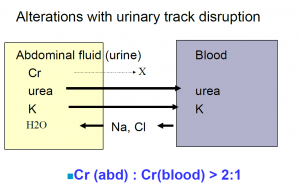Bladder, Urethra and Ureters
Uroabdomen
Uroabdomen is typically due to a ruptured bladder. Ruptured bladders are most common in neonatal colts and in ruminants with urolithiasis. Ruptured bladders are unusual in camelids and swine. In adult horses, ruptured bladders are generally associated with parturition and are not common.
Diagnostics
Abdominal distension from a ruptured bladder develops over time. Abdominal distension can occur due to many reasons. A common mnemonic is 7(or more) F words:
| Flatulence | Fetus | Fat |
| Fluid (urine, ascites, peritonitis) | Freaked out cells (neoplasia) | Free gas (ruptured bowel) |
| Frank hemorrhage | Feces (impaction) |
In the majority of neonates and young male ruminants, impactions, gas and urine would be the most common.
A fluid wave may be detectable that would suggest urine.
Animals may or may not be febrile. Heart rate and respiratory rate are usually elevated due to pressure on the diaphragm from the abdominal fluid.
Ultrasound is a key diagnostic test. With a ruptured bladder, a large amount of free abdominal fluid is visible. While a 5 MHz linear transducer is okay; 7.5-10 MHz best. Occasionally you may see collapsed bladder ± tear with fluid exiting it. Another trick is to inject “agitated” saline solution (regular saline that has been shaken up) into bladder. This makes it easier to identify the site of the tear as you watch air bubbles exiting bladder. Ultrasound can also help determine a safe site for abdominocentesis and drain placement. The thorax should also be scanned; pleural fluid isn’t common but does occur. Obviously thoracic fluid would add to the anesthetic risk unless removed via thoracic drains.
Peritoneal fluid analysis can also be used to confirm uroabdomen. Due to the size of the molecule, we use creatinine to determine if the fluid in the belly is urine or not. Creatinine doesn’t equilibrate so we can compare the abdominal fluid creatinine to the serum creatinine. If the concentration in the abdominal fluid is at least 2x the concentration in the blood, it is urine. Heating the fluid is often a quick and dirty way to tell, too.

Serum chemistry will typically show increased creatinine, BUN and potassium along with decreased pH (acidosis), sodium and chloride. PCV/TPP and white blood cells are elevated. In foals, IgG should be evaluated to ensure colostral absorption.
ECG monitoring is recommended due to the hyperkalemia (watch for tall peaked T waves due to rapid repolarization).
Treatment goals
-
- drain the urine out of the peritoneal cavity
- repair the bladder surgically or keep the bladder decompressed so it can heal via second intention (this may require a perineal urethrotomy or penile amputation)
- manage the inflammation, uremia and electrolyte disturbances
Surgical repair
Bladder repair in foals, SRC and pigs is performed under general anesthesia while standing repair can be done in some mares and conservative management (bladder decompression) may be used in large ruminants.
Key Takeaways
- Ruptured bladders occur most commonly in male foals (~ 2 days of age) and in ruminants with urolithiasis.
- Peritoneal creatinine 2x serum creatinine = urine. A quick test is to heat the sample and sniff.
Ureteral tears
Uroabdomen can also occur with ureteral tears, urachal leakage/ urachal necrosis in10-14d old foals), meconium impaction in neonatal foals and neonatal maladjustment/ septicemia.
Fillies with uroabdomen should be checked for ruptured ureters since ruptured bladders are less common. With a ruptured ureter, urine accumulates retroperitoneally, as well as intraperitoneally. While ultrasound can help in certain cases, antegrade pyelography (inject contrast into the renal pelvis and watch its exit path fluoroscopically) can be very useful in identifying any leaks in smaller patients. Scintigraphy can be used in larger animals.
Treatment involves ureteral catheterization (from the bladder) with retrograde dye infusion to identify the defect. The catheter is then advanced to the renal pelvis and the defect repaired with absorbable suture. The catheter may be left in place as a stent with distal end exited out either the urethra or via a perineal urethrotomy. In the older gelding, conservative treatment with antibiotics, NSAIDs and fluids was adequate without stenting as the ureter remained patent.
Resources
Uroperitoneum in foals, Merck online- nice overview of how these babies look

